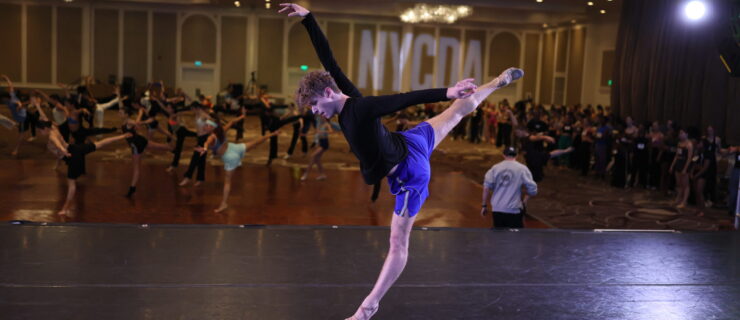Your Comprehensive Guide to Surviving Dance Competitions
Competitions offer dancers the opportunity to showcase their talents and gain valuable feedback from judges. But they can also be mentally and physically stressful, with demanding, long days of performances. How do you keep your mind and body in top condition to avoid injury or burnout? We spoke with experts about how to take care of yourself before, during, and after competitions.
Weeks and Months Before Competition
Strive to be technically and physically well-rounded.
“The best thing you can do to be really healthy throughout competition is to be thorough in your technique work year-round,” says Jenni Green, PT, MS, CFMT, and owner of PhysioArts. She also advises dancers to keep up their cross-training, even with low-impact exercises when competition rehearsals ramp up. “Cross-training outside of dance is very helpful—especially things that are symmetrical, because often dance is asymmetrical when you get into choreography,” she says. “Pilates, yoga, and Gyrotonic are all great. Straightforward ‘gym fitness’ can be helpful, too—things like basic glute, hamstring, and quad strengthening.”
Train your mind.
Quinn Callahan, artistic director and owner of The Rock Center for Dance in Las Vegas, says, “If we’re rehearsing a piece in the classroom, we will visualize the judges or the audience. Putting dancers in different scenarios helps them stay focused onstage, because they’re going to do what their bodies and minds are used to doing.”
Amp up your self-care.
“The weeks leading up to competitions are always hectic, so it’s important to take care of yourself,” says Ava Wagner, a student at Larkin Dance Studio in Maplewood, MN (and second runner-up on “World of Dance” Season 3). In addition to maintaining a regular schedule of technique classes and rehearsals, she focuses on “lots of stretching, drinking water, getting good sleep, and consuming extra vitamin C.”

Ava Wagner performing a solo (Showbiz Dance, courtesy Wagner)
Night Before Competition
Conserve energy.
To ensure their bodies are optimally rested, marathon runners don’t do long runs the day before their races. Similar advice applies to dancers: “I know for dancers it’s going to be impossible not to run your piece, but you don’t need to run it full-out,” Green says. “You can run it for memory, or you can even do visualization: Play the music and visualize yourself dancing, which actually fires all the synapses as if you were actually doing it.”
Handle logistics early to avoid day-of stress.
“Make a packing checklist. Keep a dance notebook to remind yourself of everything,” says Callahan. By the day before competition, you’ll already be packed and ready to go.”
Fuel up with a nutritious dinner.
“You want to have a solid meal that has a good amount of protein and healthy, rich carbs—like healthy grains, quinoa, or brown rice. Eat that dinner kind of early,” says Green. (If you eat too close to bedtime, it may make it harder for you to sleep, but the timing is less important than the quality.)
Prioritize shut-eye.
“A good night’s sleep is especially important the night before you compete. As hard as it is, I always try to go to bed early,” says Wagner.

The Rock Company dancers performing (courtesy Break the Floor Productions)
Day of Competition
Eat a solid breakfast.
“You want to have protein at your breakfast in combination with carbs and a little bit of fat. Don’t just grab a bagel on your way to the competition, because that’s not going to sustain you,” says Green.
Make your first warm-up count.
“You want to do a nice, thorough warm-up at the beginning of the day,” Green says. “Make sure that you’re getting your body warm with active motion. It could be a ballet barre or Pilates mat sequence—things that get your body temperature up and get you moving. Then, depending on how technical or quick your piece is, you might want to practice more specific moves.”
Avoid fatiguing exercises and passive stretching.
“These are things to avoid in any warm-up—not just for competition, but anytime you’re dancing,” Green says. “It’s not the time to do 100 sit-ups, or passively sit in the splits or straddle and hang out there—which is what dancers love to do. It’s not great right before you dance: There’s lots of science to show that your muscles are actually weaker right after you do passive stretching.”
Don’t over-prepare for that big trick.
“You want to make sure that you’re preparing yourself for what you need to do, but you’re not creating an overuse injury by repetitively doing it. What I prefer is to do the trick in a smaller-scale way, to make sure that the components are there—the balance, the flexibility, and things like that,” says Green.
Find a moment of peace.
“Having things like meditation apps can be very beneficial. It’s good to take a moment, or take deep breaths before you go onstage, because the more tense you are, the more tense your muscles will be—and that can actually set you up for injury. Staying calm is really important,” says Green. Callahan advises dancers to combat nerves during performances by “focusing on you, the movement, and being present. Dance your fullest and enjoy the experience, because you’re never going to get it back.”

Wagner dancing in a solo performance (Showbiz Dance, courtesy Wagner)
Think ahead.
When a routine is finished and you step offstage, turn your focus to your next task: “Get ready for your next number regardless of whether it’s an hour away or if it’s five minutes away,” says Callahan. This is practical (Hello, quick changes!), but also helps you stay present and avoid worrying over how your last performance was received by the judges. “No matter what happened on that stage—whether it be good or bad—it’s over. Enjoy the experience and process, and not necessarily the outcome,” she says.
Don’t stop moving right after a performance, and prepare for the next one thoughtfully.
“Walking can be helpful to bring your heart rate and body temperature back down. What I wouldn’t do is come right offstage and then sit down. Try to stay a little bit mobile. Then before the next dance you’ll have to do a warm-up, but maybe not as thorough as the first one, and more specific to the types of things that you’re going to need to do in that next piece,” says Green.
Bundle up during downtime.
To avoid cooling down completely, Callahan advises dancers to “make sure that they’re wearing sweatshirts and sweatpants, so their bodies are kept nice and warm” if they have long breaks between pieces. “A really important thing to remember is to take breaks when you get them,” says Wagner. “This is a great time for your body to rest and recover.”
Watch other performances—but take time for yourself if needed.
“Dancers should be watching to support other schools and learn. But we also know that they’re not robots, and if they do have a lot of time, sometimes they need time to themselves as well,” says Callahan.
Nourish yourself throughout the day.
“We always bring a large refillable water bottle to stay hydrated and pack healthy snacks to fuel our bodies at breaks,” says Wagner. Green suggests a banana or a handful of raisins half an hour to an hour before performances to provide bursts of energy.

Dancers from The Rock Company performing a group piece (courtesy Break the Floor Productions)
Post-Competition
Refuel quickly.
Eat a recovery snack within 30 minutes of your last performance. Green advises something with 10 to 15 grams of protein and carbs, such as chocolate milk, a hard-boiled egg and half a bagel, or peanut butter on a banana: “The carbs restore energy levels and help reduce muscle breakdown, and the protein helps build and repair muscles to help you recover more quickly.”
Now go ahead, sit in that straddle!
When you’re finished dancing for the day, bring on the passive stretching: “After your last performance, you can do all the juicy dancer stretches that everybody loves to do,” says Green. “Passive stretching, in addition to gentle warm-down movement…can be helpful to cool down the body and restore it to its baseline after high energy use all day. At the end, when your body won’t require immediate access to strength and agility, it is OK to lengthen the muscles, as opposed to doing this before dancing, which inhibits the muscles from performing at full strength and agility.”
Customize your recuperation.
“If your muscles feel fried and achy, then an Epsom salt bath is really great,” says Green. “If your joints themselves are feeling sore, then you might want to go with an ice bath or icing the joints. Elevating the legs is always great, especially if you’ve been on your feet a lot, and foam rolling can be helpful.” Wagner has taken the idea of icing to a whole new level: “In extreme cases, I have even done cryotherapy. It’s amazing how quickly you feel its results!”




